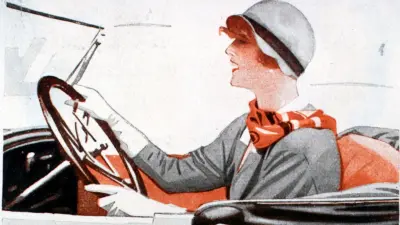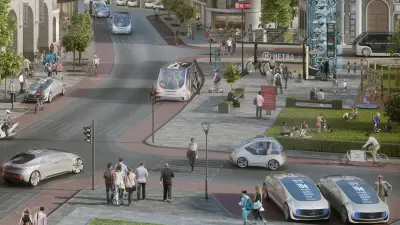No future without a past
What Bosch’s first magneto ignition device has to do with AIoT

The internet of things in combination with artificial intelligence is one of the most promising technologies of our time — and one that Bosch is embracing with a wide range of products and applications. This is part of an evolutionary process in which one technology has built on another, as we can see by looking back at the examples of electronics and electrical engineering.
A world of thinking machines: the factory 4.0
There’s a calm atmosphere in the factory. Around 100 machines are connected to each other in the clean room. An autonomous transport system carries products from the first to the last processing station — they will go through up to 700 process stages before completion. Robotic arms and automated systems perform the work, while people in special white suits take care of maintenance tasks.
This is not a distant dream. It’s what happens every day at Bosch’s first AIoT factory. At the semiconductor plant in Dresden, the technological approaches of artificial intelligence (AI) and the internet of things (IoT) work hand in hand. All of the factory’s processes are data-driven and constantly generate data themselves. More than 500 pages of information per second, or 42 million pages per day, are collected in a central repository. This data enables the smallest irregularities to be identified and analyzed — and that’s precisely where AI comes in with self-optimizing algorithms that learn to make predictions based on this data. A virtual representation of the plant, or digital twin, has been developed to simulate optimizations before they are implemented in the real factory, with the aim of making microchip production even more efficient.
Connected, self-learning chip manufacturing is just one application of AIoT. Smart, connected technologies for use at home and on the go could help make processes in our digital world simpler, more efficient, and more sustainable.
Self-learning machines are built on complex and powerful data processing techniques developed thanks to the extensive groundwork laid by Bosch, especially in automotive technology, which has been a core business area for over a century.
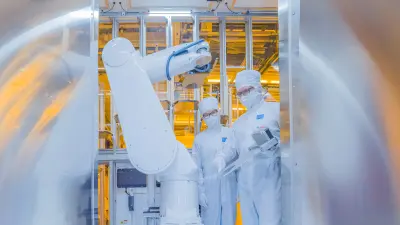
Artificial brainpower: no internet of things without electronics
Since the late 20th century, digitalization has transformed almost all areas of life. But it requires technological foundations on which it can build. At Bosch, these foundations are systems that enable useful actions or processes on the basis of complex computing operations. Thanks to their application, the Bosch electronics that revolutionized automotive technology, for example, have become part of everyday life.
“You just couldn’t get any staff. And there was no literature, either. So we had to read patent specifications!” says Karl-Ernst Boeters, an electronics pioneer at Bosch. Not exactly a promising start in the world of electronics. On top of that, established production processes did not even exist.
The late 1950s were challenging times. Bosch was gradually introducing electronics into cars and making them more suitable for everyday use, initially with simple semiconductor elements. There were no protocols to rely on, and electronics were usually designed for use at room temperatures, such as in radio transistors.
Nevertheless, experts at Bosch were convinced that electronics would make cars more reliable by reducing maintenance and repairs, and that they therefore needed to be enhanced for complex applications. The variable temperatures in cars prompted them to design integrated circuits (ICs), the ultimate in microelectronics at the time, in which microchips carried out dozens of functions in a tiny space.
Although most customers had no idea that a whole world of miniature engineering was hidden inside the engine compartment, they generally benefited from it through trouble-free driving and fewer repair shop visits.
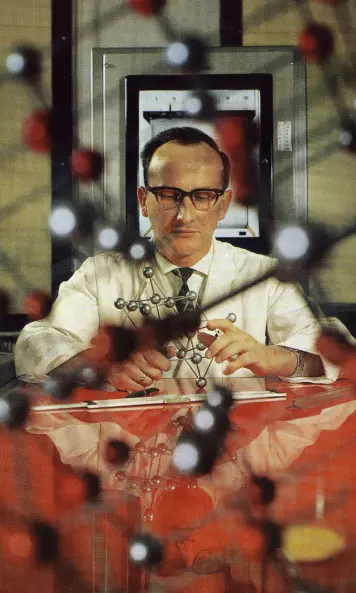

The technology became more and more powerful. In a few decades, a single microchip contained millions of transistors. Microchips were not capable of thinking in the narrower sense, let alone learning, but they automated processes and workflows.
The first in-car computers marked a crucial step forward in shifting electronics from an analog to a digital world. It was made possible by Motronic, Bosch’s engine management system comprising a microprocessor and a programmable memory. This four-byte technology was more than modest by today’s standards, but could perform complex calculations. The technological journey continued.
Everything needs power: no electronics without electrical engineering
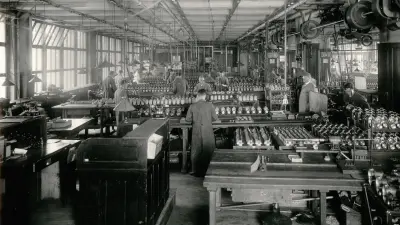
Without the vehicle electrical system from Bosch, this technological breakthrough in electronics would not have been possible.
The developments that led to this system began in 1880, when Thomas Edison invented the electric light bulb, and electricity started taking over more and more areas of life. At the same time, Werner von Siemens coined the term “electrical engineering” and suggested setting up professorships at German higher-education institutions to teach this subject.
In 1882, a young man enrolled at Stuttgart Polytechnic as a non-registered student to “overcome a fear of technical terminology.” That man was Robert Bosch. His saw his future career in electrical engineering. Spells at several electrical engineering companies, followed by a stint at Thomas Edison’s workshop in New York, gave Bosch the foundation he needed to start his own electrical engineering business. After just a few years, he achieved a major success with the magneto ignition device, a product of electrical engineering that enabled early automobiles providing reliable and safe fuel ignition.

Robert Bosch’s fast-growing company contained a lot of expertise that could be devoted to the development of further milestones in electrical engineering. Everything was in place, and Bosch’s team rapidly and precisely implemented the ideas that emerged from the research community. In 1913, the company launched the Bosch automotive lighting system, the first in-car electrical system, which consisted of headlights, a generator, a regulator, and a battery. This made it possible to store and provide energy in the car — and therefore to incorporate other electrical products such as starters, windshield wipers, and electric horns.
However, Bosch soon turned its attention to areas beyond automotive technology as well, once again bringing together expertise and technical possibilities. Refrigerators and power tools, as well as radio and television technology, were added to Bosch’s product portfolio within a short time. Manufacturing these products also required a reliable supply of electricity. As a result, the company’s Stuttgart plant installed small power generators in the basement to avoid being dependent on the initially unreliable municipal power station. This equipment made Bosch a very forward-looking company. But who would have thought at the time that, 100 years later, machines would be capable of thinking independently?
Authors: Bettina Simon, Dietrich Kuhlgatz and Christine Siegel

